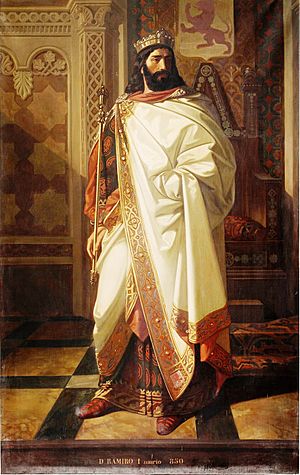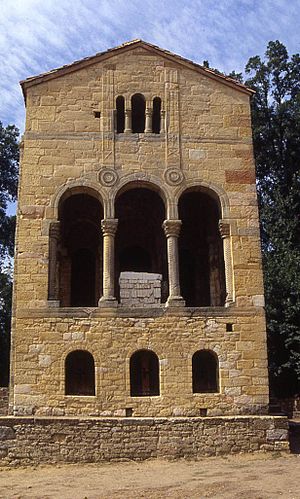Ramiro I of Asturias facts for kids
Quick facts for kids Ramiro I |
|
|---|---|
 |
|
| King of Asturias | |
| Reign | 842–850 |
| Predecessor | Nepotian |
| Successor | Ordoño I |
| Born | c. 790 Oviedo |
| Died | 1 February 850 Oviedo |
| Burial | Cathedral of San Salvador, Oviedo |
| Spouse | Paterna |
| Issue | Ordoño I |
| Dynasty | Astur-Leonese dynasty |
| Father | Bermudo I of Asturias |
| Religion | Chalcedonian Christianity |
Ramiro I (born around 790 – died February 1, 850) was the King of Asturias, a kingdom in what is now Spain. He ruled from 842 until his death in 850. Ramiro was the son of King Bermudo I. He became king after a struggle for power when the previous king, Alfonso II, passed away without children. During his time as king, Ramiro faced many challenges, including attacks from both Vikings and Moors. He was also known for a special building style called ramirense, which can be seen in his recreational palace, Santa María del Naranco. This style was an early form of Romanesque architecture. Ramiro lived at the same time as Abd ar-Rahman II, who was a powerful ruler of the Umayyad kingdom in Córdoba.
Contents
Ramiro I's Reign as King
How Ramiro Became King
When King Alfonso II died, there was a problem deciding who would be the next king in the Kingdom of Asturias. Alfonso II had no children, so he chose Ramiro, who was a distant relative and the son of the previous king, Bermudo I. At the time Alfonso II died, Ramiro was away in Castile (another region in Spain) for his wedding.
While Ramiro was away, a man named Nepocian, who was a high-ranking official and the late king's son-in-law, tried to take the throne. He had the support of people from Asturias and Vascones who were loyal to Alfonso II. Ramiro went to Galicia to gather an army. He then marched towards Oviedo, the capital. Nepocian waited for Ramiro's army by the Narcea river at Cornellana. Ramiro defeated Nepocian in a battle there, known as the Battle of the Bridge of Cornellana. Nepocian tried to escape but was caught. After being captured, Nepocian was blinded and sent to live in a monastery.
Fighting Off Viking Raiders
By the time Ramiro became king, Vikings were often sailing along the coasts of Europe. In 844, a group of Vikings landed at Corunna in Spain. They started raiding the countryside, burning and stealing. Ramiro quickly led a strong army against them. He managed to defeat the invaders, taking some of them prisoner and burning many of their ships. Because Ramiro fought them so fiercely, the Vikings stopped raiding the coastlines of Asturias.
The Legend of the Battle of Clavijo

According to a famous legend, Ramiro defeated the Moors in the Battle of Clavijo in 834. However, the date was later changed to 844 because Ramiro was not yet king in 834. This story of the battle became well-known much later, from a document that was actually made up in the 12th century. It's important to know that old records from Asturias or Arab lands at that time do not mention this battle at all. The first time it appears in writing is in the 13th century.
The story of the Battle of Clavijo seems to be a myth based on a real battle that happened later, in 859. This was the Second Battle of Albelda, where Ramiro's son, Ordoño I, and another leader crushed the forces of a Muslim ruler. In the legend of Clavijo, it is said that Saint James the Greater, riding a white horse and carrying a white flag, appeared during the battle. He supposedly helped the Asturian troops defeat the Moors. This legend helped create the strong devotion to Saint James in Spain.
Because of this supposed help from Saint James, Ramiro is said to have created a special tax called Voto de Santiago. This tax was for the benefit of the Church. However, this grant was also a fake from the 12th century. The tax was finally stopped by the Spanish government in 1812.
Trying to Rebuild León
Ramiro's biggest challenge against the Muslim kingdoms in Spain was not successful. The Muslim ruler, Emir Abd ar-Rahman II of Córdoba, also had to deal with Viking invaders and rebellions within his own lands. Ramiro tried to use this chance to rebuild the city of León, which had been abandoned.
However, this attempt to repopulate León did not last long. Abd ar-Rahman II quickly dealt with the Vikings and the rebels. In 846, he sent an army led by his son. This army forced the Christian people to leave León again, and the Muslims then burned the city. León was not settled again until 856, during the reign of Ramiro's son, Ordoño I.
Internal Problems and Strict Justice
While Ramiro's kingdom was mostly free from outside attacks, the later part of his rule saw many conflicts inside Asturias. As mentioned, becoming king was difficult for him, and he continued to face unhappy and rebellious nobles. Old records mention two of these rebels. After defeating a powerful noble named Piniolo, Ramiro ordered him and his seven sons to be put to death. Another rebel leader was blinded.
Ramiro was also very strict with thieves, whose numbers increased during his reign. He was also strict with "magos," which likely meant people who still followed old pagan beliefs in isolated areas. An old record praises Ramiro as "the Rod of Justice," meaning he was a very fair and firm ruler.
Family, Children, and Who Came Next
We don't know much about Ramiro's first marriage, except that his son, Ordoño, was already an adult when Ramiro became king. Ordoño became king of Asturias after his father's death.
Ramiro married his second wife, Paterna, around 842. This was the same year King Alfonso II died. A record written by Ramiro's grandson says that Ramiro was in Castile for his wedding when Alfonso II died. This suggests his wife was from Castile. It is believed that this bride was Paterna, who was later known as his widow.
There is no strong proof of other children besides Ordoño. Traditionally, Count Rodrigo of Castile (who died in 873) has been named as a son of Ramiro and Paterna. However, some historians believe that Rodrigo might have been connected to the royal family through Queen Paterna, but not necessarily as her son.
Ramiro might also have been the father of Gatón, who was a Count. An old Arab book from the 14th century says that Gatón was the "brother" of Ordoño I.
Death and Burial Place
Ramiro died on February 1, 850. He passed away in his palace at Santa María del Naranco, which is on Mount Naranco near the city of Oviedo. He was buried in the Pantheon of Asturian Kings inside the Cathedral of San Salvador, Oviedo, next to his second wife, Paterna. His tomb, which no longer exists, was next to the tomb of the king before him, Alfonso II.
The "Ramirense" Style in Buildings
The art and buildings from Ramiro's time are part of the "Ramirense" phase of Pre-Romanesque Asturian art. His royal court was very grand and beautiful. The palace and church of Santa María del Naranco and the church of San Miguel de Lillo are examples of this. On the slopes of Mount Naranco, near Oviedo, Ramiro I ordered the building of the Santa María del Naranco palace and a church called San Miguel de Lillo. The church partly collapsed later, and only about a third of it remains today. Other buildings that were part of the palace complex are gone. Another example of Ramirense architecture is the church of Santa Cristina de Lena, about 30 kilometers from Oviedo. The palace and these two churches have been named World Heritage Sites by UNESCO.
Ramirense architecture used barrel vaults made of tufa, which is a light type of limestone. This was new and special, not just for the region but for Europe at the time. Other buildings, even in Muslim Spain, usually had wooden roofs.
See also
 In Spanish: Ramiro I de Asturias para niños
In Spanish: Ramiro I de Asturias para niños



